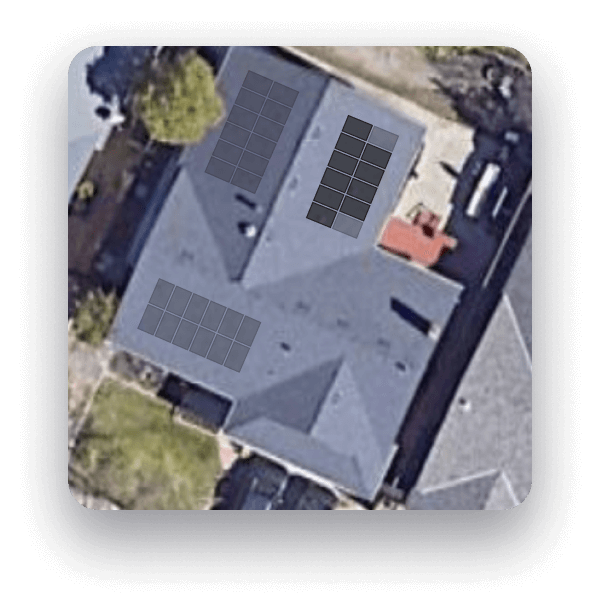Are you curious if solar power is right for you (and your home)? Our solar guide to roofing is a great starting point.
Now is a great time to go solar, and as we know, moving toward home electrification has numerous benefits. It’s a great time to consider integrating climate technology into your home, from energy savings to reducing your carbon footprint (and using energy more efficiently).
Getting the most out of your solar panels depends a lot on factors such as:
- Roof slope or pitch
- Home’s latitude
- Placement of the sun
This question frequently arises with homeowners looking to move toward solar power: does the type of roofing material matter when installing solar panels?
Here at Monalee, we want to make building a sustainable lifestyle as simple as possible. Let’s examine how these different factors affect where solar panels are installed and what you can expect depending on your location and roofing materials.

What Roof Pitch and Material Mean for Solar
What is roof pitch (or slope), and how does it affect solar panel performance?
The amount of energy solar panels can capture depends largely on the sunlight they’re exposed to. And because panels essentially sit just a few inches above the roof, the pitch or slope impacts how much energy they’ll absorb.
How do you figure out what your roof’s slope or pitch is? It’s time to dust off those geometry skills.
Slope (also known as the pitch) = rise/run
When measuring out 12 inches from the roof horizontally (run), the slope is the number of inches vertically (rise).
Using this illustration, the roof slope is 7:12 or a 30.26-degree angle. Other possibilities for roof slopes include:
- 3:12 pitch – 14.04°
- 4:12 pitch – 18.43°
- 5:12 pitch – 22.62°
- 6:12 pitch – 26.57°

Generally, homeowners within the United States have a roof pitch between 30 and 45 degrees. Another way to get an estimate of your slope is to match it up based on where your home is situated along the latitude lines.
While plenty of online tools can help you figure out your roof pitch, scheduling a site survey will provide you with all the information you need to move forward with solar installation. As important as roof slope is, other factors that can also impact solar power performance include:
- Inclination – the angle at which the sun hits solar panels
- Orientation – placing panels where they’ll receive the most sunlight
- Shade – determining if shade (by foliage or surrounding buildings) will impact solar panel performance
- Roofing type – materials and color can impact solar panel efficiency due to absorbancy or reflection
As roof slope and orientation affect solar panel efficiency, roofing materials can be equally important. Heat retention and reflection are influenced by the type of material used (and color), which can ultimately affect the amount of solar energy panels create.
Let’s look at some of the common types of roofing materials and how they might impact solar production.

Top 5 Types of Roofing Materials
The best roofing materials for your home might vary depending on where you live.
What a homeowner in Arizona wants on the roof might differ from what someone in the Pacific Northwest needs. Color also matters, too. Lighter colors and materials reflect light, while darker colors absorb heat.
These factors all affect whether solar panels work as effectively as possible and can impact how energy is used within the home to keep things cool.
Whether you are interested in how solar installation works for your existing roof or you’re considering changing the materials before installing solar, here are the five most common types of roofing materials:
Asphalt shingles
As the most common type of roofing material, asphalt shingles accommodate many factors homeowners look for in a roof, including affordability, durability, and style.
Because of different styles, asphalt shingles look aesthetically pleasing for most home designs and create an even surface for solar panels, but they aren’t the most energy-efficient choice.
While new technologies are at work to make asphalt shingles more reflective, traditional shingles absorb a lot of heat (up to 100 degrees) and sunlight, increasing home temperatures and causing shingles to crack and curl over time.
Cedar shake
Cedar shake roofing materials lend a rustic beauty to a home’s architecture. In addition to curb appeal, cedar shake is often 100% natural, durable, and sustainable, making it a great choice for a home.
There are a few downsides, though. Extreme temperatures can cause cedar shake shingles to dry out, which leads to splitting. Though cedar shake is known to be resistant to bugs and rot, humid temperatures can impact quality over time.
Composite
Homeowners interested in choosing composite roofing materials have more choices today than ever.
By combining materials such as asphalt, fiberglass, rubber, and paper, homeowners can choose a roof style that matches the aesthetic they want without the downsides of that particular material. Composite shingles are highly durable to avoid cracking and splitting and are lightweight, ideal for older homes and structures that can’t withstand the burden of heavier materials.
Metal
Though more expensive than asphalt shingles, homeowners increasingly opt for metal roofing because it lasts between 40 and 70 years.
As a versatile material that has the ability to expand and contract to accommodate heat and weather conditions, metal roofing materials are low-maintenance and can mimic the style of more traditional materials such as shingles or tile.
Regarding energy efficiency, metal roofing materials reflect sun and UV rays to reduce the home’s cooling costs.
Slate roofing
Slate and tile roofing are more expensive than shingles, but their longevity more than makes up for the cost in the long run. These materials can last between 50 and 200 years, depending on the climate and the care that goes into maintaining the roof.
Another benefit of slate roofing is that it’s a highly durable and natural material resistant to mold, temperature, fire, and water damage.
Can you install solar panels on a slate roof? Yes! While it requires a bit more planning, install partners often remove tiles to mount hardware and then replace tiles in their proper place.

Moving Forward with Solar Panels
Roof slopes and materials play a role in solar panel installation, but an experienced installation partner can help you determine the best way to proceed with your home. The site survey is an excellent way to learn about what you can do to maximize your investment and make any recommended changes to transform your home into an energy-efficient abode.


























